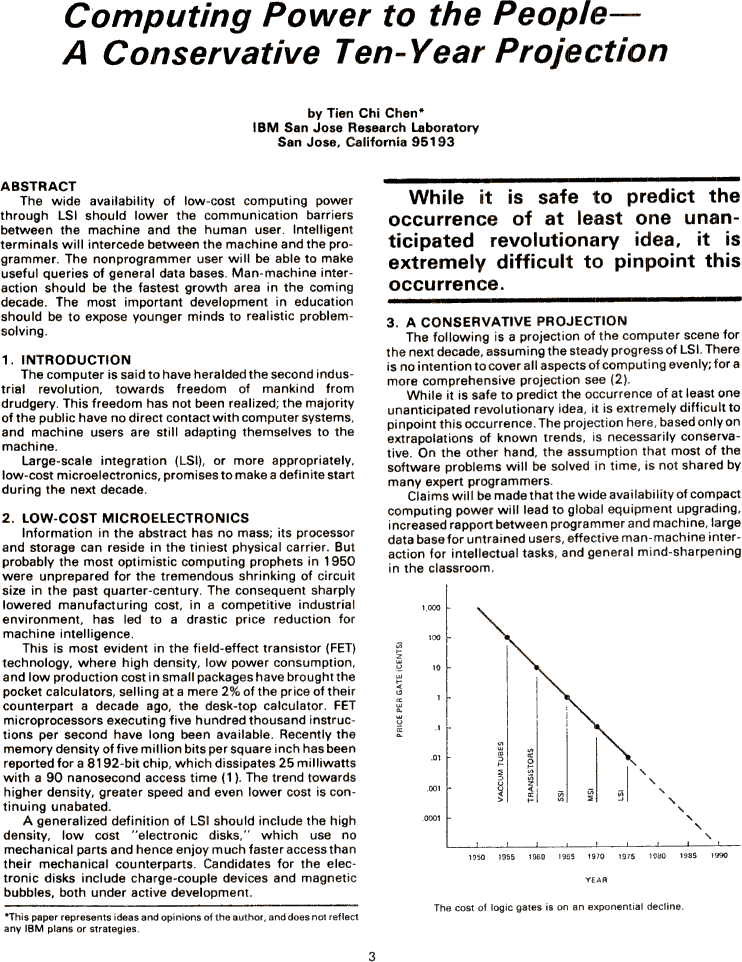by Tien Chi Chen

Computing Power to the People - A Conservative Ten-Year Projection by Tien Chi Chen* IBM San Jose Research Laboratory San Jose, Califonia 95193 ABSTRACT The wide availability of low-cost computing power through LSI should lower the communication barriers between the machine and the human user. Intelligent terminals will intercede between the machine and the programmer. The nonprogrammer user will be able to make useful queries of general databases. Man-machine interaction should be the fastest growth area in the coming decade. The most important development in education should be to expose younger minds to realistic problemsolving. 1. INTRODUCTION The computer is said to have heralded the second industrial revolution, towards freedom of mankind from drudgery. This freedom has not been realized; the majority of the public have no direct contact with computer systems, and machine users are still adapting themselves to the machine. Large-scale integration (LSI), or more appropriately, low-cost microelectronics, promises to make a definite start during the next decade. 2. LOW-COST MICROELECTRONICS information in the abstract has no mass; its processor and storage can reside in the tiniest physical carrier. But probably the most optimistic computing prophets in 1950 were unprepared for the tremendous shrinking of circuit size in the past quarter-century. The consequent sharply lowered manufacturing cost, in a competitive industrial environment, has led to a drastic price reduction for machine intelligence. This is most evident in the field-effect transistor (FET) technology, where high density, low power consumption, and low production cost in small packages have brought the pocket calculators, selling at a mere 2% of the price of their counterpart a decade ago, the desk-top calculator. FET microprocessors executing five hundred thousand instructions per second have long been available. Recently the memory density of five million bits per square inch has been reported for a 8192-bit chip, which dissipates 25 milliwatts with a 90 nenosecond access time (1). The trend towards higher density, greater speed and even lower cost is continuing unabated. A generalized definition of LSI should include the high density, low cost "e|ectronic disks," which use no mechanical parts and hence enjoy much faster access than their mechanical counterparts. Candidates for the electronic disks include charge-couple devices and magnetic bubbles, both under active development. While it is safe to predict the occurrence of at least one unanticipated revolutionary idea, it is extremely difficult to pinpoint this occurrence. 3. A CONSERVATIVE PROJECTION The following is a projection of the computer scene for the next decade, assuming the steady progress of LSI. There is no intention to cover all aspects of computing evenly; for a more comprehensive projection see (2). While it is safe to predict the occurrence of at least one unanticipated revolutionary idea, it is extremely difficult to pinpoint this occurrence. The projection here, based only on extrapolations of known trends, is necessarily conservative. On the other hand, the assumption that most of the software problems will be solved in time, is not shared by many expert programmers. Claims will be made that the wide availability of compact computing power will lead to global equipment upgrading, increased rapport between programmer and machine, large data base for untrained users, effective man-machine interaction for intellectual tasks, and general mind-sharpening in the classroom. [image]VACCUM TUBES TRANSISTORS SSI MSI LSI 100 10 1 .1 .01 .001 .0001 PRICE PER GATE (CENTS) 1950 1955 1960 1965 1970 1975 1980 1985 1990 YEAR The cost of logic gates is on an exponential decline.

